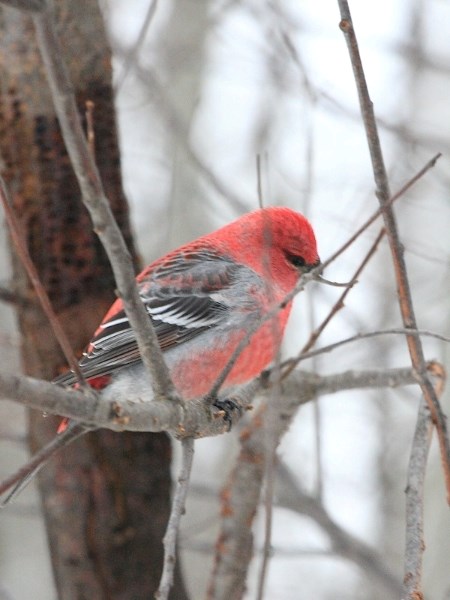For the eighteenth year in a row volunteers from across Athabasca came together for an event that was for the birds.
In the mild weather of last Tuesday morning (Dec. 27), eleven volunteers, divided into six teams, fanned out across the town with the task of recording every feathered flyer they caught a glimpse of, all part of the annual Athabasca Christmas Bird Count.
In addition to the count done by the eleven volunteers, 22 Athabasca residents had their eyes on their bird feeders for three days before and after the day, known as count week.
The event, a joint effort between the Crooked Creek Conservancy Society and Science Outreach Athabasca, saw the volunteers track and record over 2,000 individual birds representing 31 different species both common and rare to the area.
Once compiled, that data will be submitted to Bird Studies Canada and the National Audubon Society, both of which gather information from Christmas counts across North America.
From two majestic Bald Eagles and a rare Gyrfalcon to the more numerous Common Redpoll and Black-capped Chickadee, the event served to show off the real diversity of the Boreal forest that the town is situated in.
Harvey Scott, co-organizer of the event, explained that the draw of counting birds is recognition of the natural world many take for granted.
“That’s the real gift of it,” he said. “Although the Boreal forest seems less diverse than some places, such as Costa Rica, the point is each place has its own unique special beauty.”
He specifically pointed out the wide array of dazzling colours flaunted by Blue Jays and the reds and yellows of two species of Grosbeaks.
“Very often humans live somewhere and they may know their human neighbours, but that’s a very small fraction of the neighbours around them,” he said, adding that the recognition of those neighbours helps us appreciate the ecosystem we are a part of.
Overall, the preliminary numbers reflected the general trend of the number of species in the region. Since the count started in 1994, the number of species recorded has ranged from the mid-twenties to low thirties.
One of the highlights of the count was the appearance of a full set of woodpeckers; Downy, Hairy, Pileated and the uncommon Northern Three Toed and Black Backed.
The total number of birds spotted has dropped, however, confirming the anecdotal data given by area birders and nature lovers.
“The relative scarcity of birds was noticed this fall and early winter, both at feeders and in the bush,” Scott said.
Unable to give a conclusive reason as to why numbers are down, he said it may have something to do with the warm winter and lack of snow, which has allowed birds to stay in the forest.
He added that as human development continues, all species have to compete more and more with each other for places to eat and breed.
On a more sombre note, he noted the loss of long-time naturalist and birder Fred Korbut, of Boyle, who died in September. With an encyclopedic knowledge of the area’s plant and animal species, Korbut played an integral role in establishing the bird count and promoting stewardship.
With that he encouraged residents to take an interest in the surrounding wilderness and volunteer for next year’s bird count, promising an enlightening and engaging experience.
“You’ll come out once and get hooked on it,” he said.
Anyone who would like to get involved in next year’s bird count, or the migratory bird count which happens in May, can contact Scott at 780-675-4158 or Wayne Brehaut of Science Outreach at 780-675-4461.
Full results from bird counts since 1994 can be found on the Audubon and Bird Studies Canada websites.



